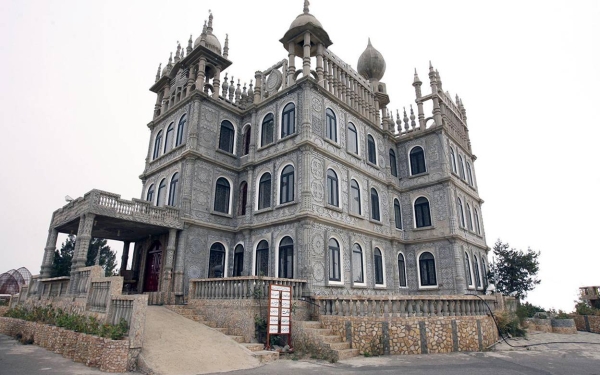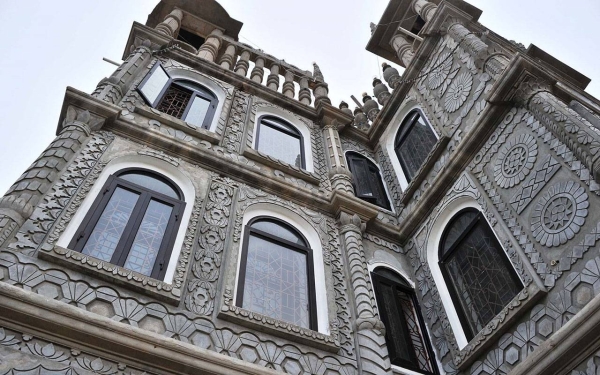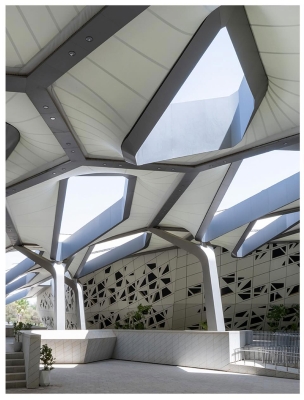

An-Namas Museum or an-Namas Heritage Palace is a museum located in Aseer Province, southwest of the Kingdom of Saudi Arabia. It is one of the most important museums in the province, as it houses heritage and archaeological pieces, inscriptions, and historical documents. It is situated in an-Namas Governorate, within the old neighborhood that was built nearly 250 years ago. It stands as an architectural masterpiece and a model of architecture in this part of the region.
Collections of an-Namas Museum
The museum, which was opened in 1999, encompasses over two thousand heritage and archaeological antiquities, including most of the heritage pieces in the province. The museum boasts five floors, with exhibition halls, including the agricultural tools hall, household tools hall, weaponry hall, women's outfit hall, and a documents and inscriptions hall.
The agricultural tools hall in an-Namas Museum
The agricultural tools hall is divided into three rooms containing plowing tools, such as the shabna, mugrina, sharfa', mashat, kadoom, mainab, and qutban. It also houses tools for traditional water extraction from wells, such as the dirayah, the wheel, ghurab, and ropes.
The hall also contains harvesting tools, such as the sickle and shareem, in addition to agricultural harvest transportation tools, such as the qutban, ropes, straw mat, zanbeel, drill, and a net. Moreover, the hall contains tools used in grain filtering and purification, such as the Dwais stone, maqlaba, maima, 'athra, a sieve, muwakhal, and tanaka.
The hall also includes grain and crop storage tools, such as the maiaan and aiba, as well as tools placed on animals used in farming, such as the ghamama, qutb,aiba, kharj, qiyad, khitam. Moreover, the hall contains weighing and measuring tools, such as the mad, thumna, and ruba'.
The household tools hall in an-Namas Museum
The household tools hall is divided into three rooms. The first contains kitchen appliances that include utensils used for cooking, which are made of clay, pottery, copper, and flint stone, such as the raha, tawra, yahl, and the copper pot. Some pots used for fire cooking, such as the markib, mirfa, mashoufa, tannour, mifa, masha, mihrak, mihmas, milqat (tweezers), mashbah, dafour, yaza, quz, as well as food preserving tools, coffee making tools, tools for preserving water, milk, and cheese, etc.
The second hall includes Arabic traditional council tools, such as silal, maameel, sieves, dallal, lammah, kouz, maraki, cushions, sufra, and gaed. The third hall contains bedroom tools, such as qaada, firash al-khasf, sayariya, the wood trunk, mukhala, mirror, mudhana, iron for clothes, etc.
Weaponry hall in an-Namas Museum
The weapons hall contains Arab and foreign rifles, janabi, swords, daggers, belts, sufuf, shields, Arabic fuse, makmaa, namis, mahdach, maachar, hatfa, pistols, gunpowder and bullets for each rifle, janabai of all kinds, nafiae, kadimiya, blade, dagger, swords, spears, pikes, and revolver. The hall also contains men's clothing during times of war, celebrations, and holidays, as well as an armor, sash for the waist, gunpowder bowl, and iron shield.
Women's outfit hall in an-Namas Museum
The museum also includes a women's outfit hall (Women's Corner). It contains clothes worn by women in their daily lives, such as the Aseeri robes and mukalaf (embroidered) robes. It also contains jewelry and silver jewelry women use for adornment at weddings, festivals, and celebrations, such as Qanna', mindil, shiyal, silver belts, maaded, bracelets, and other tools.
A documents and inscriptions hall in an-Namas Museum
An-Namas Museum includes a special hall for documents and inscriptions. It contains several documents about the daily interactions and correspondences among tribes, their representatives, and sheiks. It also includes tribal laws, conflict settlements, and reconciliation of disputes and transgression, in addition to many archaeological stone inscriptions that tell the history of the province, with displays of rock writings displayed inside the museum.
Ways of life at an-Namas Museum
The museum's courtyard displays models of stone construction methods, methods of extracting water from underground, some Islamic writings on rocks, heritage tools, and a model of ovens that were used in ancient times.
Related quizzes
Related articles


